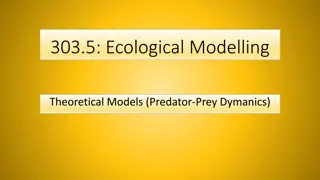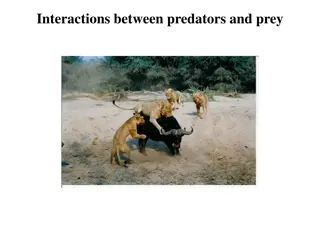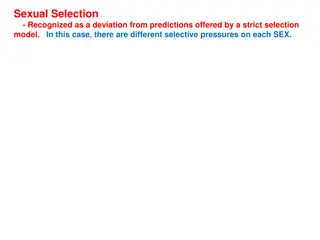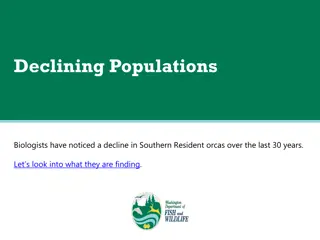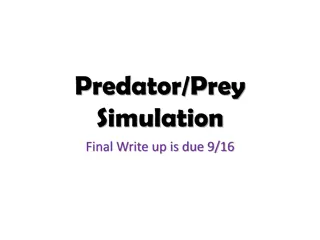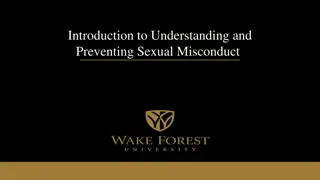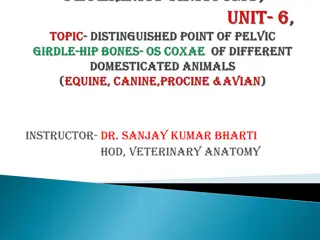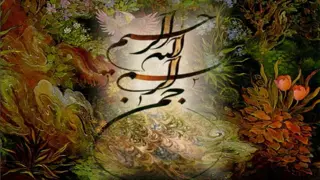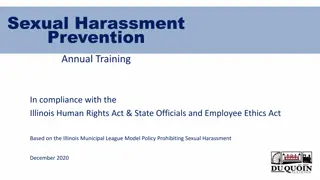Understanding Reversed Size Sexual Dimorphism in Birds of Prey
Reversed Size Sexual Dimorphism (RSD) in birds of prey challenges the traditional norm where females are larger than males. This phenomenon can be advantageous to both sexes in terms of ecological niche partitioning, role differentiation, and behavioral adaptations. The study focuses on the Strigiformes (owls) and Falconiformes (falcons and hawks) including species like the Snowy Owl and Peregrine Falcon, highlighting evolutionary hypotheses and ecological impacts.
Download Presentation

Please find below an Image/Link to download the presentation.
The content on the website is provided AS IS for your information and personal use only. It may not be sold, licensed, or shared on other websites without obtaining consent from the author. Download presentation by click this link. If you encounter any issues during the download, it is possible that the publisher has removed the file from their server.
E N D
Presentation Transcript
Reversed Size Sexual Dimorphism (RSD) In Birds of Prey By: Angel Gosnell
What is RSD? Reverse of the norm In normal size dimorphism, males are typically larger than females due to intrasexual selective pressures. In RSD, females are larger than males. How could this be advantageous to the male? To the female?
Our Subjects: Strigiformes Owls Snowy Owl Nyctea scandiaca
Our Subjects: Falconiformes Falcons and Hawks Red-shouldered Hawk Buteo lineatus Peregrine Falcon Falco peregrinus
Hypotheses of Evolution and Maintenance Small Male (retained female ancestral size) Large Female (retained male ancestral size) Selective pressures favoring large female and small male size Great Horned Owl Bubo virginianus
Ecological Hypothesis Niche partitioning Lessens prey competition between the sexes Dimorphism allows for better exploitation of the available prey base and lessens survival competition between the sexes(Krueger 2005;Ydenberg RC, Forbes LS. 1991). Doesn t predict which sex becomes larger (Krueger 2005; Ydenberg RC, Forbes LS. 1991). Great Horned Owl Bubo virginianus
Role Differentiation Hypothesis Males and females have divided work load in raising fledglings Large female: Role Larger energy base to produce a larger egg size, larger clutch size, and shorter incubation periods. (Krueger 2005; Ydenberg RC, Forbes LS. 1991). Small male: Role/Energy Saving Increased foraging efficient or territory defense due to an increase in flight efficiently Fast-prey specialization Hunting strategies Food provisioning Territorial defense Saves energy New Zealand Falcon Falco novaeseelandiae
Behavioral Hypothesis 3 pathways Large female Increased female dominance higher food provisioning/reproductive rate Decreased cannibalism (Smith 1982), increased safety Large Female Intrasexual competition for males; where females compete for males Increases sexual dimorphism: plumage and size. Doesn t correspond with Jones (1997) model .. Small Male: Mate Selection Increased agility and flight maneuvers Intersexual competition for females Showing off good genes and hunting ability Snowy Owl Nyctea scandiaca
Some Evidence Pleasants and Pleasants (1998) Falconiformes Female increased in size due to change in hunting strategies of females or the male .most likely the male Male retained original size Strigiformes Males decreased in size Females and egg size either did not change from their plesiomorphic state or as female size increased egg size changed proportionately. Female retained original size
RSDs Evolution Krueger s (2005) comparative analysis Falconiformes Strong correlates between foraging Fits with the small male hypothesis in that males evolved to become smaller in response to increased foraging efficiency. RSD evolved via a change in hunting strategies resulting in higher reproduction. Strigiformes Evolutionary analysis suggests that RSD evolved due to natural selection rather than sexual selection in owls because RSD evolved before specialization on more agile prey (Krueger 2005).
Tengmalms Owls: Natural Selection over Sexual Selection? Difference in good vs bad prey years No significant difference in male reproductive output in good vole years Small males: higher reproductive success in low vole years Increased reproductive output through out life compared with large males Females benefit from good nutrition . female body size directly proportional to egg size in both years (Hakkarainen H, Korpimaeki E. 1991, 1993). Tengmalm s Owl Aegolius funereus
Suggestions McDonald, Oslen, and Cockburn (2004) many researchers have failed to look at specific environmental factors that affect raptor RSD in specific species and/or specific populations Arak (1988) suggests that a single selective pressure on one sex without considering other forces does not explain sexual dimorphism. Sexual dimorphism must arise from differing selectional pressures on body size for each sex.
Conclusions No conclusive evidence to the evolution of RSD To study one sex over the other is bias Determination of ancestral body size and reproductive characters, such as egg size and clutch size, provides crucial evidence to support or debunk any hypothesis Logistical problems in determining pleiotropic characters impede proving either hypothesis. Red-shouldered Hawk Buteo lineatus
Bibliography Arak A. 1988. Sexual dimorphism in body size: a model and atest. Evolution. 42:820-825. Bateman AJ. 1948. Intrasexual selection in Drosophila. Heredity. 2:349-363. Darwin C. 1871. The descent of man and selection in relation to sex. London: Murray. Hakkarainen H, Korpimaeki E. 1991. Reversed sexual size dimorphism in Tengmalm's owl: Is small male size adaptive? Oikos. 61(3):337-346. Hakkarainen H, Korpimaeki E. 1993. The effect of female body size on clutch volume of Tengmalm's owls (Aegolius funereus) in varying food conditions. Ornis Fennica. 70(4):189-195. Jones AG, Avise JC. 1997. Microsatellite analysis of maternity and the mating system in the Gulf pipefish (Syngnathus scovelli), a species with male pregnancy and sex-role reversal. Mol Ecol. 6:203-213. Krueger O. 2005.The Evolution of Reversed Sexual Size Dimorphism in Hawks, Falcons and Owls: A Comparative Study. Evol Ecol. 19(5): 467-486. McDonald PG, Olsen PD, Cockburn A. 2005. Selection on body size in a raptor with pronounced reversed sexual size dimorphism: are bigger females better? Behav Ecol. 16(1):48- Trivers, RL. 1972. Parental investment and sexual selection. In: B. Campell, editor. Sexual selection and the descent of man. Aldine Press: Chicago, p. 136-179. Ydenberg RC, Forbes LS. 1991.The survival-reproduction selection equilibrium and reversed size dimorphism in raptors. Oikos. 60(1): 115-120. 56.


